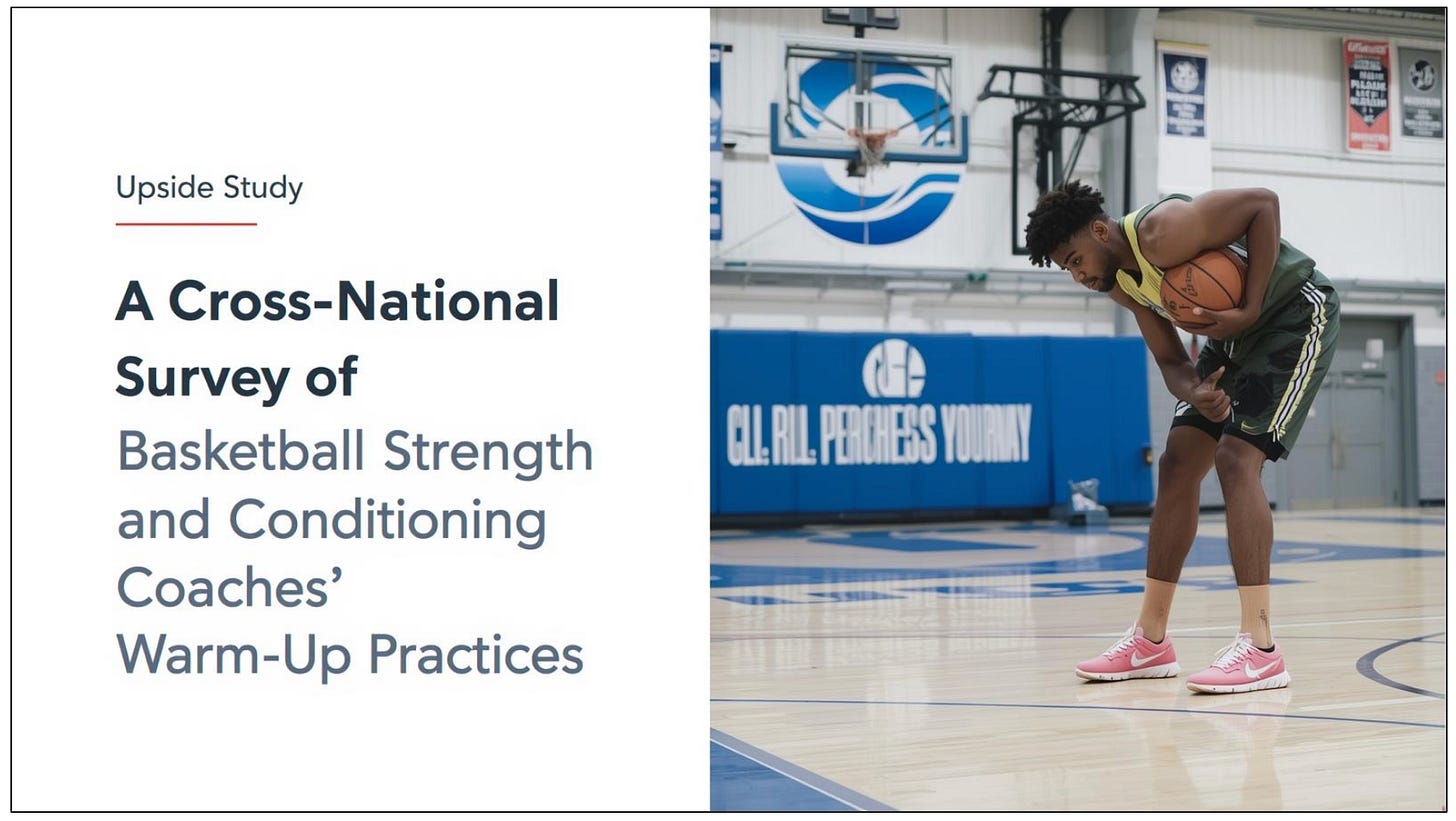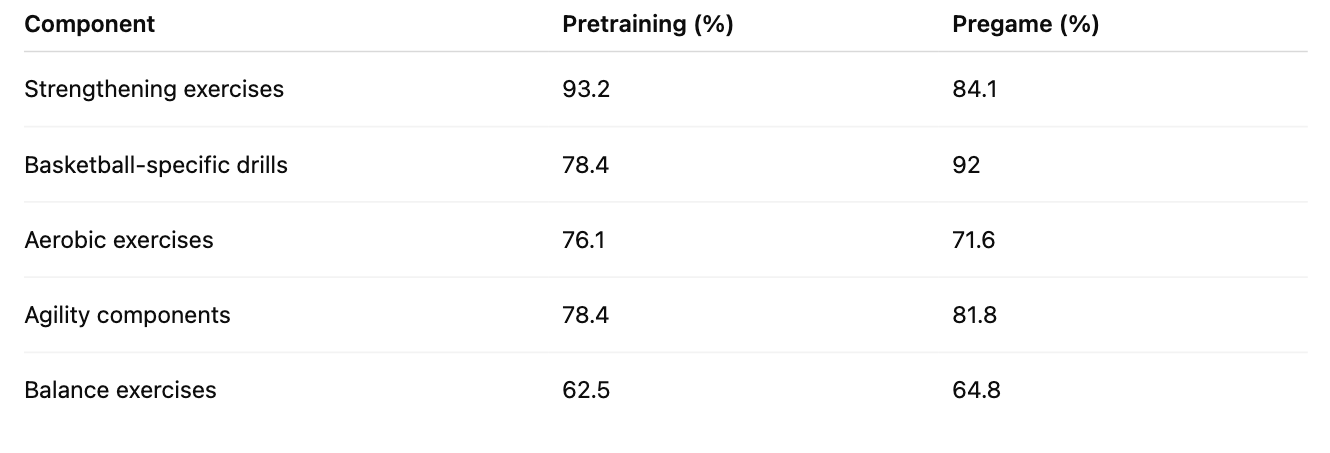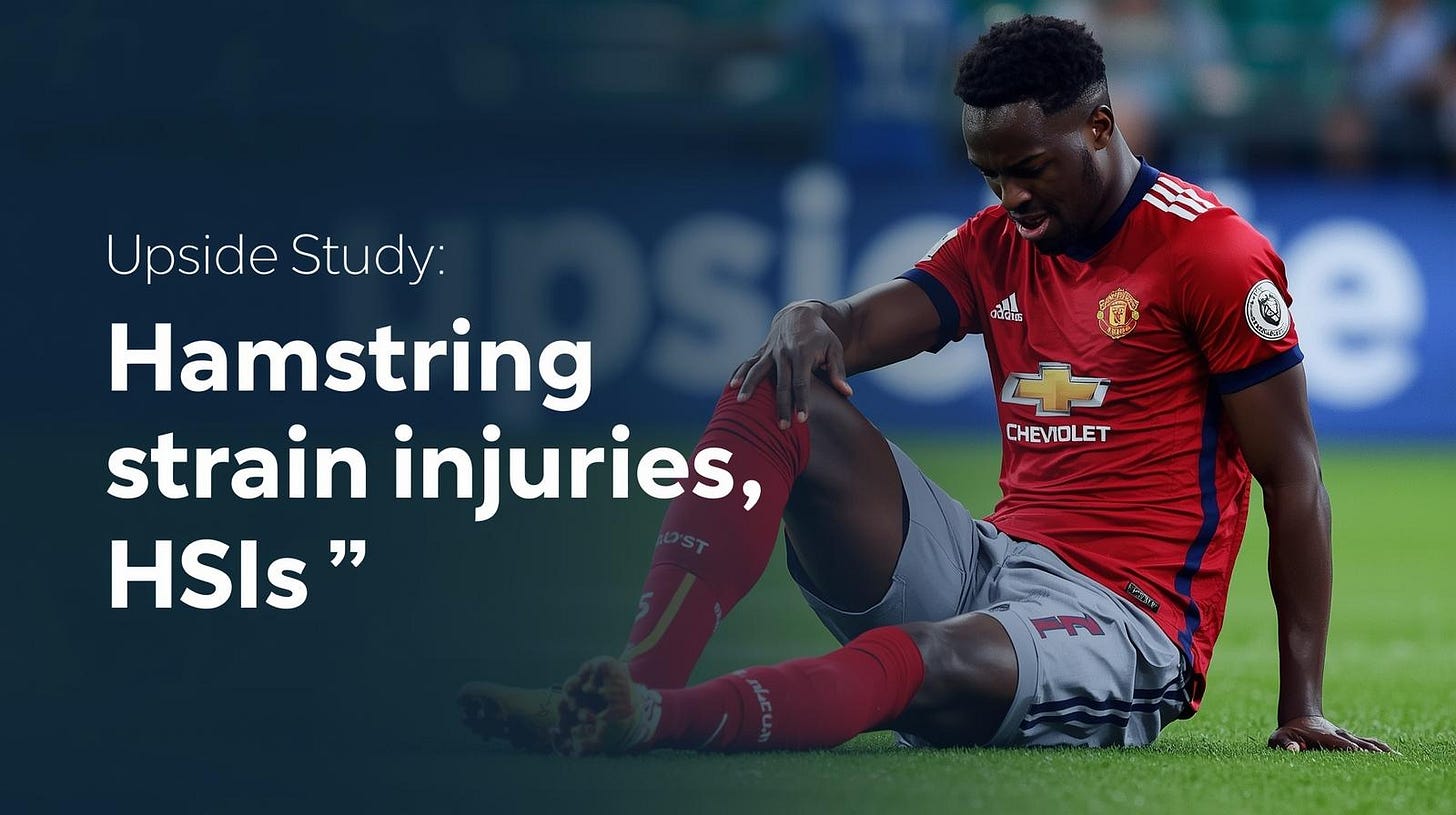📚 Upside Studies: (1) NBA / FIBA Study: S&C Coaches’ Warm-Up Practices. (2) NFL Study: ACL Injuries (3) Study: Hamstring strain injuries (HSIs)
🏀 Upside Study: A Cross-National Survey of Basketball Strength and Conditioning Coaches’ Warm-Up Practices
🧩 Introduction
Warm-up routines are fundamental to basketball performance preparation, serving as a bridge between rest and high-intensity activity. They not only elevate muscle temperature and improve oxygen uptake kinetics but also prepare athletes psychologically and tactically for training or competition. In basketball—a sport defined by rapid transitions, frequent jumps, and explosive multidirectional movements—well-structured warm-ups can enhance neuromuscular readiness, optimize technical execution, and reduce the risk of soft-tissue and joint injuries.
Despite widespread recognition of their importance, there remains substantial variation in how strength and conditioning (S&C) coaches structure warm-ups. Many rely on experiential knowledge rather than standardized, evidence-based guidelines, particularly across different competition levels and between male and female programs.
This study, “A Cross-National Survey of Basketball Strength and Conditioning Coaches’ Warm-Up Practices,” provides the first large-scale, international insight into current warm-up practices in basketball. Conducted across 19 countries and multiple professional leagues—including the NBA, WNBA, EuroLeague, and FIBA competitions—the study analyzes how S&C coaches structure pretraining and pregame warm-ups, the rationale behind their design, and how these routines differ by competition level and sex.
Authors: Enrique Flórez-Gil, Daniel Boullosa, Julio Calleja-González, and Alejandro Vaquera
Institutions: Universidad Isabel I; Universidad de León; Federal University of Mato Grosso do Sul; James Cook University; University of the Basque Country; EuroLeague Players Association
Published in: International Journal of Sports Physiology and Performance (Ahead of Print, 2025)
You can download the full article by clicking the link above.
🧪 Study Overview
Design: Cross-national descriptive survey
Study Period: March – December 2023
Participants:
88 basketball strength and conditioning coaches
Representing 19 countries across Europe, the Americas, Asia, Africa, and Oceania
Working across elite leagues including NBA, WNBA, EuroLeague, and FIBA competitions
78.4% male, 21.6% female
Eligibility Criteria:
Coaches held a university degree and a minimum of three years of experience in professional or elite-level basketball.
Survey Structure:
A 15-item online questionnaire (Google Forms) combining open-ended and multiple-choice questions. It explored:
Warm-up objectives (e.g., injury prevention, skill enhancement, readiness)
Duration and structure (pretraining vs. pregame)
Components used (e.g., aerobic, strength, balance, sport-specific)
Equipment and methods
Differences by sex and competitive level
Analysis:
Responses were analyzed descriptively and using chi-square tests to identify differences by gender and competition category.
📈 Key Findings and Statistical Results
🎯 Warm-Up Objectives
The most commonly cited goals were:
Injury prevention: 83%
Physical and psychological preparedness / general conditioning: 80.7%
Increasing body temperature: 69.3%
Skill development: 52% of men’s teams vs. 33% of women’s teams
These findings underscore a strong emphasis on readiness and injury mitigation, consistent with the latest literature on basketball performance optimization and neuromuscular activation programs.
⏱️ Warm-Up Duration
Warm-up length varied considerably between pretraining and pregame contexts:
Pretraining sessions: 10–15 minutes most common (48.9%)
Pregame: Exceeded 30 minutes in 38.6% of men’s teams and 44.4% of women’s teams
This indicates a trend toward longer, more comprehensive pregame routines, possibly reflecting greater emphasis on technical, tactical, and psychological preparation before competition.
However, the authors note potential risks: previous studies show that excessively long warm-ups (>20 minutes) can lead to early fatigue and thermoregulatory strain, potentially diminishing explosive performance.
💪 Warm-Up Composition
Key insights:
Strengthening work (e.g., core stability, band resistance, isometrics) was the most universally included element, underscoring its role in both activation and injury prevention.
Basketball-specific drills were primarily featured in pregame routines (92%), reinforcing their importance for tactical readiness.
Balance and proprioceptive exercises were present in roughly two-thirds of programs—vital for mitigating ankle and lower-limb injury risk.
Some coaches also reported including mobility, proprioceptive, and decision-making drills, reflecting growing integration of cognitive and neuromuscular activation methods.
🧰 Format and Equipment Use
Mixed (individual + group) warm-up format: 80.7%
Use of equipment (e.g., resistance bands, mini-hurdles, foam rollers): 82.6% overall
Highest among female teams (up to 100% in elite and youth-elite levels)
These findings point toward a more individualized, hybrid model of preparation—balancing group cohesion with targeted activation based on player needs and injury history.
📊 Contextual Differences by Gender and Competition Level
Women’s teams:
Tended to perform longer warm-ups and use more structured equipment routines.
Men’s teams:
Placed slightly higher emphasis on skill refinement and explosive readiness.
Youth categories:
Adopted shorter and less equipment-intensive routines, suggesting opportunities for better standardization and education at developmental levels.
🧠 Implications for Coaches, Practitioners, and Sports Scientists
This study highlights a sophisticated, evolving landscape of basketball warm-up design:
Integration of multiple objectives: Modern warm-ups serve not just physiological but also technical and cognitive purposes.
Shift toward personalization: The predominance of mixed-format and equipment-assisted routines indicates a move toward individualized activation strategies within team structures.
Need for load monitoring: Coaches are encouraged to track warm-up intensity using tools such as RPE, countermovement jump (CMJ) metrics, or Player Load from inertial tracking systems to balance readiness and fatigue.
Injury prevention synergy: The consistent inclusion of strength, balance, and agility elements aligns with proven neuromuscular injury-prevention frameworks, such as SHRed and FIFA 11+ adaptations for basketball.
📌 Practical Recommendations
For Performance and Medical Staff:
Implement structured but adaptable warm-up protocols that include resistance activation, mobility, and sport-specific tasks.
Avoid unnecessarily prolonged sessions (>25–30 min) that may induce fatigue.
Use wearable or subjective monitoring tools to adjust workload and track readiness.
Prioritize education and standardization in youth and female programs to ensure consistent best practices.
For Researchers and Governing Bodies:
Develop validated warm-up models tailored to the physiological and tactical demands of basketball.
Expand studies to underrepresented populations (female and youth athletes).
Explore links between warm-up content, duration, and subsequent injury rates or performance outcomes.
⚠️ Limitations
Self-reported data: No observational verification of actual warm-up routines.
English-only survey: May have limited participation from non-English-speaking coaches.
Underrepresentation of women (21.6%) reduces generalizability.
Potential self-selection bias, as more motivated or experienced coaches may have been more likely to participate.
✅ Conclusion
This international survey delivers the most comprehensive snapshot to date of warm-up practices among basketball strength and conditioning coaches. Across continents and competition levels, coaches consistently prioritize injury prevention, readiness, and sport-specific activation, typically through mixed, equipment-supported routines lasting 10–30 minutes.
While practices differ in duration and emphasis, the underlying principles—progressive activation, neuromuscular readiness, and contextual adaptation—are widely shared. The study underscores the growing sophistication of applied warm-up design and the need for continued integration between science and on-court practice.
Future work should aim to establish evidence-based frameworks that optimize warm-up efficiency, balance performance enhancement with injury prevention, and reflect the unique physiological and cognitive demands of modern basketball.
🏈 Upside Study: Player Tracking Metrics to Predict Risk of Anterior Cruciate Ligament Injuries During Change-of-Direction Scenarios in the National Football League
🧩 Introduction
Anterior cruciate ligament (ACL) injuries remain one of the most significant health and performance burdens in the National Football League (NFL), with particularly high rates occurring during special teams plays and change-of-direction (CoD) movements. These injuries often happen in milliseconds—faster than the body can reflexively respond—and are most frequently noncontact or indirect contact in nature.
While prior studies have focused on video analysis and qualitative biomechanical assessments, recent advancements in player tracking technology (e.g., Next Gen Stats by Zebra Technologies) now allow for precise quantification of movement intensity, including speed, acceleration, and deceleration power. This provides a new data-driven avenue for understanding ACL injury mechanisms during in-game CoD scenarios.
This study aimed to integrate synchronized video and player tracking data to identify predictive motion characteristics of ACL injuries during CoD scenarios in the NFL between 2018 and 2022.
Authors:
Cody M. O’Cain, MS; Paul M. Inclan, MD; E. Meade Spratley, PhD; Kristy B. Arbogast, PhD; David J. Lessley, PhD; W. Britt Evans, MS; Ben Stollberg, MS, ATC; and Robert H. Brophy, MD
Institution: Biomechanics Consulting and Research, LLC, Charlottesville, Virginia, USA.
🧪 Study Overview
Design: Retrospective observational (descriptive epidemiology) study.
Time Frame: 2018–2022 NFL seasons.
Data Sources: NFL Electronic Medical Record System, synchronized with Next Gen Stats (player tracking) and game video.
Participants:
216 ACL injuries (missed-time injuries).
All 32 NFL teams, across regular season, preseason, and postseason games.
100 of these identified as change-of-direction (CoD) injury scenarios.
Tracking Metrics Analyzed:
Distance traveled (m)
Speed (m/s)
Acceleration (m/s²)
Normalized deceleration power (W/kg)
Model Used:
Generalized Linear Mixed Model (GLMM) with covariates for season, play type, position, player experience, and prior ACL history.
Compared:
BASE-ALL: All ACL injuries.
BASE-CoD: Only CoD ACL injuries.
PT-CoD: CoD model including tracking metrics (max speed, deceleration power).
📈 Key Findings and Statistical Results
🚨 Mechanisms and Scenarios
46% of all ACL injuries occurred during change-of-direction (CoD) scenarios.
74% were noncontact (32%) or indirect contact (42%).
98% of players were decelerating at the time of injury.
Median speed at injury: 5.3 m/s; median deceleration: 3.0 m/s².
🏈 Play Type & Position Patterns
Punt (71%) and kickoff returns (75%) had the highest CoD ACL injury rates.
Linebackers had the largest share of ACL injuries (64% CoD-related).
Wide receivers, cornerbacks, and quarterbacks also frequently sustained CoD ACL injuries.
Players with <4 years of experience had slightly higher CoD injury proportions (48%).
⚙️ Predictive Tracking Metrics (PT-CoD Model)
Model comparison:
PT-CoD model (AIC = 2225) outperformed BASE-CoD (AIC = 2318).
Once tracking metrics were included, play type (e.g., punt/kickoff) no longer independently predicted ACL risk—indicating that movement intensity, not play design, drives injury probability.
🧠 Implications for NFL Teams and Performance Staff
High-speed decelerations are the key biomechanical signature of ACL injuries in football.
Monitoring maximum speed and deceleration loads in real-time can help quantify athlete exposure to risky movements.
CoD injury risk is mechanically universal, cutting across play type and position once movement metrics are considered.
Preseason remains a high-risk period—likely due to lower conditioning or higher effort intensity from players competing for roster spots.
For Coaches and Sports Scientists:
Integrate tracking-based load management for speed and deceleration exposure.
Design neuromuscular training emphasizing eccentric control during deceleration and visual reaction drills.
Use tracking data to simulate game-intensity CoD events safely in training environments.
📊 Recommendations
For NFL and Elite Programs:
Use player tracking to identify high-intensity exposure thresholds (e.g., 5.5+ m/s speed combined with >10 W/kg deceleration).
Incorporate these thresholds into return-to-play and load-monitoring protocols.
Expand models to include practice data and pose-based biomechanics for more complete injury risk forecasting.
For Sports Tech Developers:
Develop predictive in-game risk alert tools that integrate speed and deceleration metrics.
Use machine learning to automatically detect CoD movements from tracking data for proactive workload management.
⚠️ Limitations
Did not include practice or training exposures (data unavailable).
Exposure events were not manually filtered for CoD only due to volume (>5 million plays).
Findings are specific to NFL athletes and may not generalize to other levels or sports.
Further biomechanical validation (e.g., ground reaction force estimates) is needed to refine predictive modeling.
✅ Conclusion
ACL injuries in the NFL are predominantly change-of-direction, noncontact or indirect contact events involving high-speed deceleration.
The two strongest predictors of injury risk were:
Maximum speed, and
Normalized maximum deceleration power.
These findings emphasize that motion intensity, not simply contact or play type, drives ACL risk.
Player tracking data offers a powerful, objective tool for both injury surveillance and prevention, paving the way for real-time risk modeling and improved athlete safety across professional football.
⚽ Upside Study: Practices and perceptions in hamstring training for injury prevention and enhancement of athletic performance: A qualitative analysis
🧠 Introduction
Hamstring strain injuries (HSIs) remain one of the most persistent and costly musculoskeletal injuries across elite sport, particularly in soccer and rugby. Despite an extensive body of research on prevention and rehabilitation, hamstring injuries continue to increase in frequency. In elite European football, HSIs now account for approximately 20–24% of all reported injuries, a doubling of incidence since the early 2000s. These injuries not only sideline athletes for extended periods but also present significant challenges for high-performance teams, balancing player availability, match readiness, and long-term athletic development.
While the Nordic hamstring exercise (NHE) has become a cornerstone in evidence-based prevention programs, the translation of research into applied environments remains inconsistent. Surveys of elite teams suggest that despite clear evidence supporting the NHE’s efficacy, its adoption across professional football remains low — often due to misconceptions about soreness, poor integration into congested schedules, or lack of interdisciplinary alignment.
This study—conducted by researchers from the University of Salford and Edith Cowan University—sought to move beyond survey data to understand how and why practitioners make programming decisions in the real world. Using semi-structured interviews with strength and conditioning (S&C) coaches and physiotherapists, the authors explored the contextual, cultural, and practical factors shaping hamstring training practices aimed at both injury prevention and performance enhancement.
By focusing on lived practitioner experiences, the study provides rare qualitative insights into how elite practitioners interpret research, manage multidisciplinary team (MDT) dynamics, adapt to fixture congestion, and tailor training loads in complex sporting environments.
Authors:
Steven Ross¹, Nicholas J. Ripley¹, and Paul Comfort¹,²
¹ University of Salford, School of Health & Society, UK
² Edith Cowan University, School of Medical and Health Sciences, Australia
Published: September 2025 | International Journal of Sports Science & Coaching
📊 Study Design & Methods
🧪 Participants and Approach
Sample: 12 applied practitioners (11 S&C coaches and 1 physiotherapist)
Sports represented: Soccer (majority), rugby, and lacrosse
Experience: 1–15+ years across youth and professional levels
Locations: Primarily United Kingdom, with one participant from Argentina
Interview duration: 26–57 minutes
Format: In-person and online (Microsoft Teams)
Analysis tool: NVivo 12 Plus software
Analytical framework: Thematic analysis following Braun & Clarke (2006)
The study adopted a semi-structured interview design, allowing for both consistency in topic coverage and flexibility in exploring individual perspectives. This approach enabled in-depth exploration of practitioner rationales, biases, and situational constraints—areas often missed in survey-based research.
🎯 Discussion Domains
Practitioners were interviewed across six broad areas:
Practitioner profile and job role
Key challenges in reducing HSIs
Resistance training practices and barriers
High-speed running (HSR) and sprint exposure
Athlete testing, monitoring, and risk profiling
Views on scientific literature and research translation
🧮 Thematic Analysis
Ten initial codes were distilled into five overarching themes:
Areas for professional development of practice
Athlete testing, monitoring, and profiling
Athlete values, beliefs, and education
Job role challenges
Programming strategies and micro-dosing practices
This thematic approach provided a comprehensive lens through which to interpret the nuanced realities of applied practice in elite sport.
💡 Key Findings & Insights
🧩 1. Areas for Professional Development
Practitioners expressed a strong desire to improve their understanding of dose–response relationships in hamstring training—particularly regarding minimal effective loads, individualized prescription, and the balance between eccentric, isometric, and concentric stimuli.
Several coaches highlighted a shift in their programming philosophy: moving away from high-volume Nordic hamstring prescriptions (e.g., 3–4 sets of 8–10 reps) toward low-volume, high-compliance micro-dosing strategies (e.g., 1–2 sets of 3–4 reps, multiple times per week). This evolution aligns with emerging evidence suggesting meaningful strength and architectural adaptations can occur even with small but frequent eccentric exposures.
“Earlier research had us doing high volumes of Nordics because that’s what the data said. But in practice, compliance dropped. Now, smaller doses spread across the week have been far more sustainable.”
Practitioners also emphasized ongoing education—both their own and their athletes’—to ensure scientific recommendations are understood, contextualized, and applied effectively in team settings.
📊 2. Athlete Testing, Monitoring, and Profiling
NordBord testing was the most common method for evaluating hamstring strength, often normalized to body mass (e.g., target thresholds of 10–12 N·kg⁻¹). However, participants questioned rigid benchmark values, noting wide individual variability in both body composition and game demands.
“A blanket threshold doesn’t work. Some of our smaller athletes may never hit 10 N/kg, but they’re functionally strong and rarely injured.”
High-speed running exposure was monitored using GPS systems, with practitioners emphasizing individualized thresholds rather than arbitrary speed cutoffs. HSR and sprint “top-ups” were strategically implemented for players who had limited exposure in games—such as goalkeepers, substitutes, or players returning from injury.
“We review sprint exposure every week. If a player hasn’t hit enough high-speed meters, we’ll top them up with one or two sprints at near-max effort.”
These insights highlight the growing sophistication of individualized monitoring in modern performance systems, though variability in interpretation and data use remains a barrier to consistency.
🧠 3. Athlete Values and Education
Practitioners unanimously described athlete education and engagement as crucial to program success. They emphasized the importance of clear communication about exercise purpose, benefits, and expected sensations.
Rather than prescribing exercises blindly, coaches fostered collaborative relationships with athletes—seeking to improve both compliance and understanding. Interestingly, contrary to earlier assumptions, muscle soreness (DOMS) was not a major deterrent to participation.
“We rarely get pushback on Nordics anymore. The volume is low, the soreness is manageable, and players see the results.”
Education was also used to correct misconceptions—such as athletes misinterpreting exercises like the Romanian deadlift (RDL) as upper-body work—by reinforcing the biomechanical rationale behind movement patterns like the hip hinge.
“We spend time teaching why a hinge matters. Once players feel it in the right place, their engagement skyrockets.”
⚙️ 4. Job Role Challenges
Practitioners described the dual pressures of fixture congestion and multidisciplinary coordination as the greatest operational barriers.
With congested schedules (e.g., two or more matches within 96 hours), maintaining adequate recovery while preserving training stimulus was a constant negotiation. Coaches emphasized that close communication with the technical coaching staff was critical for balancing tactical sessions with physical preparation.
“If we don’t align with the coaching staff’s plan, we either under-train or overload. The best environments plan collaboratively—down to drills.”
Some practitioners lamented limited MDT collaboration, describing siloed operations where communication breakdowns compromised training load management and recovery planning.
“When the MDT isn’t aligned, it’s chaos. You’re firefighting injuries instead of preventing them.”
🏋️♂️ 5. Programming Strategies
The most striking insight was the nuanced evolution of hamstring programming in elite sport.
a. Resistance Training Approaches
Coaches emphasized movement quality and technical competency over aggressive load progression—particularly at youth levels. Many described the use of a movement competency framework, progressing athletes from basic squats to more advanced hip hinge patterns before loading.
“Our progression isn’t about weight—it’s about movement. Once the pattern is solid, load follows naturally.”
At senior levels, however, some practitioners noted stagnation—where players rarely progressed to heavy loading (>85% 1RM). This may inadvertently contribute to the high HSI rates seen in older athletes.
b. Micro-Dosing and Isometric Alternatives
During fixture congestion, coaches favored micro-dosing strategies (e.g., 1–2 sets of 3 NHE reps) to maintain eccentric exposure while minimizing fatigue. Isometric substitutes were commonly used in high-load weeks to preserve strength adaptations without exacerbating soreness.
“We micro-dose Nordics through the week—it’s enough to maintain adaptation without impacting freshness.”
c. High-Speed Running Integration
Most HSR exposure occurred during match play; however, practitioners were proactive in implementing targeted sprint sessions for athletes who lacked adequate exposure. These sessions often emphasized maximal intent, competitiveness, and sport-specificity (e.g., curved or angled sprints to reflect in-game patterns).
“We use short, competitive races in training. It keeps intent high and better reflects the demands of match play.”
🧠 Discussion
This qualitative study provides a rare, inside look at how practitioners actually operationalize hamstring training in high-performance sport. The findings reveal that while evidence-based principles (e.g., NHE, progressive overload, eccentric emphasis) are acknowledged, their application is heavily shaped by context, culture, and constraints.
Practitioners blend science and pragmatism, balancing training stimulus with player fatigue, fixture congestion, and coaching preferences. The widespread adoption of micro-dosing, individualized thresholds, and dynamic monitoring reflects a sophisticated evolution of applied practice—moving toward ecologically valid, athlete-centered programming.
The study also highlights persistent gaps:
Limited empirical data on minimum effective eccentric doses
Uncertainty around optimal HSR exposure and load distribution during congested periods
Need for better integration between MDT members to align training priorities
Overall, practitioners are highly engaged with current research but require practical, flexible frameworks that account for the realities of elite sport environments.
⚠️ Limitations
Small sample size (n=12), primarily UK-based
Self-reported qualitative data may introduce bias
Findings not directly generalizable beyond elite sport settings
Limited female athlete representation
✅ Conclusion
This study reinforces that effective hamstring injury prevention and performance enhancement are as much about context as content.
Key takeaways include:
Micro-dosed, low-volume NHEs are widely used and improve compliance without sacrificing efficacy.
Integrated HSR monitoring and individualized sprint exposure are vital for maintaining eccentric capacity and reducing injury risk.
Education, communication, and MDT collaboration are the backbone of successful applied practice.
Progressive overload—both mechanical and neuromuscular—must be re-emphasized, especially in senior players.
Future research should aim to establish minimum effective dosages, develop ecologically valid concurrent training models, and explore how contextual factors (travel, congestion, coaching philosophy) affect adaptation and injury risk.
You may also like:
⭐Upside Studies: Genetic profile in genes associated with muscle injuries and injury etiology in professional soccer players
Title: Genetic profile in genes associated with muscle injuries and injury etiology in professional soccer players
📚 Upside Studies: (1) Factors Defining Success During Basketball Overtimes (2)Athlete's Sleep (3) ACL Injury in Basketball
🛏️ Upside Study: Sleep and the Athlete: Narrative Review and 2021 Expert Consensus Recommendations
📚 Upside Studies: (1) MLB Study: Elbow Surgeries (2) NBA Study: A Comparative Analysis of Jordan's Bulls and Curry's Warriors (3) Soccer Study: Retirement Age
⚾ Upside Study: Epidemiology of Elbow Medial Ulnar Collateral Ligament Surgeries in Major and Minor League Baseball Pitchers








